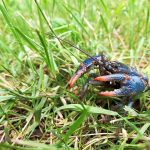Uncommon Monongahela blue crayfish among burrowing species in region

Crayfish are fairly common in the Southwestern Pennsylvania region; their reddish-brown shells observed regularly in various waterways.
One color you don’t expect to see on the small crustacean, however, is blue.
But if you come across a Monongahela crayfish, a mellow blue shell is exactly what you’ll encounter.
According to the International Union for Conservation of Nature, which maintains a Red List of Threatened Species, the blue crayfish is found in two separate subpopulations — one along the Appalachian Plateau in West Virginia and Pennsylvania, and another along the Appalachian Mountains of West Virginia and Virginia.
“This species is rare throughout its range, though this may reflect the difficulty in locating burrowing crayfish in Pennsylvania,” according to IUCN. “It is known from 21 counties in West Virginia, while its range in Virginia is somewhat unknown.”
And I know it’s found in at least one county in Pennsylvania, as we discovered one in the damp lowlands on our property in Washington County earlier this summer.
Upon first perusal, it may appear that the blue-tinged crayfish was the recent prey of a raccoon or cat, taking on the colorless tone that other small insects, reptiles or animals have when they’re losing oxygen.
Initially, that’s what I thought it was, until a friend noted its true identity. Further research helped solidify that it was indeed a rarely seen Monongahela crayfish.
The IUCN website further indicated that the blue crayfish is a primarily burrowing species and can be found on wooded hillsides and hilltops, in springs and seeps.
“This species collects leaf litter in autumn and young are born in February and March, remaining in the borrow until September/October,” they said. “This species prefers upland wooded area, with clean water and is unlikely to be able to tolerate habitat loss or degeneration.”
Unlike crayfish that you commonly find in crevices or under rocks in waterways, blue crayfish are considered burrowing crayfish. Their telltale homes are tall, muddy cylinders called chimneys, according to a report from the Pennsylvania Natural Heritage Program.
“Crayfish burrows can be several feet deep and quite complex, consisting of multiple entrances and tunnels. Crayfish generally reside in their burrows year-round, coming out periodically to forage (often on moist, rainy nights),” the report said.
They added that the blue crayfish are one of three burrowing crayfishes in western Pennsylvania.
“Burrowing crayfish are important components of the ecosystems in which they reside. For example, burrowing crayfish provide critical habitat for the eastern massasauga rattlesnake and Kirtland’s snake; both species are Pennsylvania endangered and both hibernate in crayfish burrows,” the report said. “Additionally, crayfish burrows provide critical habitat for endangered odonates (dragonflies and damselflies) and other invertebrates, especially during the summer when surface waters dry up.”
When you’re out and about this summer, especially in lowlands during warm, dewing spells, keep an eye out for the unique muddy chimneys and uncommon blue crustacean.

